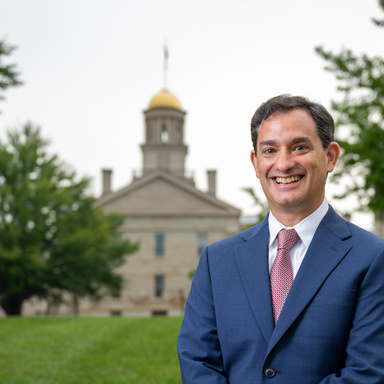
What is your vision for the Office of the Vice President for Research (OVPR)?
Well, let me answer that in a few ways. First, we’ll continue to do what we do well – serve the campus research community, assure the university and our researchers are compliant with relevant state and federal regulations, and help our talented researchers, scholars, and artists conduct world-class work that improves the human condition in Iowa and across the country and world.
Second, we will continue to pursue the goals of innovative research and creative discovery laid out in the existing University of Iowa Strategic Plan.
Third, I hope to develop a few new initiatives and programs. Research development will be a priority – how can we help our faculty, staff, and trainees be successful in their research and scholarly pursuits?
What do you want to accomplish in your first 100 days on campus?
My top priority is to listen and learn. Every day for these first few months, I am meeting with relevant groups both within and outside OVPR. I am reading written documents, visiting our space, and learning our budget. I will travel to Washington to meet our federal representatives. I will meet with shared governance representatives. In short, I want to understand our culture, our history, and our opportunities.
From there, I can work with relevant stakeholders on campus – including shared governance, the President and Provost, and our own internal OVPR team to determine what is working well, what might need some adjusting, and what capacity we have for new initiatives to support research, scholarship, and creative activity across the campus.
What vital lessons did you learn during your time in administration at University of Alabama at Birmingham (UAB)?
I served in several different leadership roles at UAB. A few were particularly relevant to this position. I worked for several years as associate dean for research in the College of Arts and Sciences, where I oversaw research, scholarship, and creative activity across the natural sciences, social sciences, arts, and humanities.
For the last four years, I served in an associate vice president for research role, overseeing research facilities and infrastructure across the UAB campus. In that position, I participated in all aspects of the Vice President for Research office but was especially focused on topics such as:
- research space, construction, and renovation of new facilities and buildings,
- maintaining shared scientific core facilities, and
- animal research programs.
I also spent time in department leadership as vice chair and director of undergraduate studies in psychology as well as interim chair for a year each in social work and in philosophy.
UAB is a terrific university with many parallels to Iowa, and I’m certain many of the processes, successes, and lessons that I learned at UAB will translate nicely to my work here at Iowa.
You’re a returning Hawkeye. What are you most excited to revisit now that you’re back in Iowa City?
Yes, I spent five wonderful years here in Iowa City as a graduate student in the late 1990s. I've already had an opportunity to return to a few of my favorite restaurants and bars, and I will continue to visit others in the coming months as I settle in. I can’t wait to attend Big 10 football games again – there’s nothing like the atmosphere in Kinnick on a home game day!
I look forward also to exploring the breadth of the area with a new lens. I’m at a different stage of life now with different priorities. My wife and I will enjoy the natural beauty of the area, restaurants featuring cuisines from around the world, and the arts and cultural community with maturity and life experience we didn’t have 25 years ago.
What’s your proudest accomplishment as a researcher?
Wow, that’s a tough one!
An easy answer would be scholarly. Papers published in Science, Nature, Lancet. Reaching an h-factor of 100 and i10 of 300. Winning a third simultaneous R01 grant.
Also important to me was publishing my book, Raising Kids who Choose Safety, which translated my research on child injury prevention to a popular audience and helps parents keep their children safe and healthy.
But perhaps my proudest accomplishment is seeing my trainees succeed in their own career. I now have several students who trained under me – both at the undergraduate and graduate level – succeeding in their own scholarly careers. It is so rewarding to see your trainees excel.
You’ve researched youth safety and injury prevention during your career. As a parent, what wouldn’t you let your children do?
Ha, good question! It's healthy for parents to let their children explore – that's how they grow. We can never learn to walk without taking that first step. We can never learn to drive without turning the key for the first time. So, children should be encouraged to explore, push their limits, and try new things. Of course, there are limits – we parents have better judgment than our children and we sometimes need to recognize for our children when an activity could lead to injury. In those cases, parents should intervene.
There are relatively few things I absolutely prohibited my children from doing, but I was watchful. When they were young on the playground, I probably “spotted” them excessively, assuring that if they were to fall, I could soften the blow. As they grew older, I probably watched them more carefully than average when they crossed streets or parking lots. I let them go independently, but kept a careful eye, knowing I could re-direct in case of emergency. And now, as they enter young adulthood and engage independently in the world, I hope that I have trained them to take risks, but to do so safely. Life can be fun if you have adventures and push yourself to new activities, but you also need a dose of inhibition and caution to stay safe.